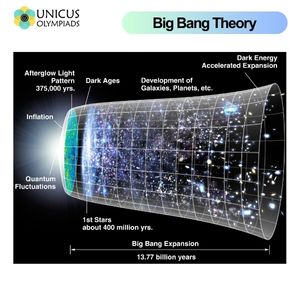

The Big Bang Theory is the leading scientific explanation for the origin of the universe. It describes how the universe began as a singular, extremely hot and dense point approximately 13.8 billion years ago, and has been expanding ever since. This theory is supported by a wide range of astronomical observations and provides a coherent framework for understanding the evolution of the cosmos, from its earliest moments to the vast and complex universe we observe today. In this article, we will explore the Big Bang Theory in detail, explain how it accounts for the universe's origin, and examine the evidence that supports it.
The Big Bang Theory was first proposed by Belgian physicist and priest Georges Lemaître in the 1920s, who suggested that the universe originated from a singular "primeval atom" that exploded and began expanding. The theory gained widespread acceptance after further developments in the field of cosmology, particularly through the work of scientists like Edwin Hubble and Albert Einstein, and the discovery of cosmic microwave background radiation in the 1960s. Today, the Big Bang Theory is the dominant explanation for the universe's origin and is supported by a variety of scientific observations.

The Big Bang Theory posits that the universe began as an infinitely small, hot, and dense point, sometimes referred to as a "singularity," approximately 13.8 billion years ago. From this state, the universe rapidly expanded in an event known as the Big Bang, and has continued to expand ever since. The expansion of space-time itself is what causes galaxies to move away from each other. Over time, the universe cooled, allowing matter to form and eventually leading to the development of galaxies, stars, and planets.
The Big Bang Theory suggests that the universe began as an extremely small, hot, and dense point known as a singularity. This singularity contained all the mass and energy of the universe. It had no size and was infinitely dense, and the laws of physics, as we understand them, were not applicable at this point.
Just fractions of a second after the Big Bang, the universe underwent a period of incredibly rapid expansion known as cosmic inflation. During this brief period, the universe expanded exponentially, growing from smaller than a subatomic particle to the size of a melon in an incredibly short time. This rapid expansion helped to explain the uniformity of the universe that we observe today, smoothing out any irregularities in the distribution of matter.
As the universe continued to expand and cool, subatomic particles such as quarks, protons, and electrons began to form. After a few minutes, these particles combined to form the first atomic nuclei, primarily hydrogen and helium. This process is known as nucleosynthesis and took place within the first few minutes after the Big Bang.
Approximately 380,000 years after the Big Bang, the universe had cooled enough for atoms to form. This period is known as recombination, where electrons combined with protons and nuclei to form neutral atoms, primarily hydrogen and helium. The formation of these atoms allowed light to travel freely through space for the first time, creating the first observable light in the universe.
As the universe continued to expand and cool, matter began to clump together due to gravity, forming the first stars and galaxies. The first stars formed around 200 million years after the Big Bang, marking the beginning of the "cosmic dawn." Over billions of years, galaxies merged, stars formed, and the universe evolved into the structure we see today.
One of the strongest pieces of evidence for the Big Bang Theory is the discovery of cosmic microwave background radiation (CMB). The CMB is faint radiation that is a remnant of the heat from the early universe. It was first detected in 1965 by Arno Penzias and Robert Wilson, and it provides a snapshot of the universe when it was just 380,000 years old. The CMB is uniform across the sky, which is consistent with the idea of an initial hot, dense state that expanded rapidly.
Another critical piece of evidence is the observation of the redshift of galaxies. In the 1920s, astronomer Edwin Hubble discovered that galaxies are moving away from each other, and the farther they are, the faster they appear to be receding. This phenomenon is known as the Hubble’s Law and suggests that the universe is expanding. The redshift of galaxies is an observable effect of this expansion, and it supports the idea of an expanding universe, which is a key prediction of the Big Bang Theory.
The Big Bang Theory predicts that the universe should have specific proportions of light elements, such as hydrogen, helium, and lithium, based on the conditions present during nucleosynthesis. Observations of the chemical composition of the universe, particularly in distant galaxies and nebulae, match the predicted abundances of these elements, providing further evidence for the Big Bang Theory.
One of the ongoing implications of the Big Bang Theory is that the universe continues to expand. As galaxies move farther apart, the space between them grows, and the universe is predicted to continue expanding indefinitely. This discovery has led to various theories about the ultimate fate of the universe, including scenarios like the Big Freeze, where the universe continues to expand and cool, or the Big Crunch, where the universe eventually collapses in on itself.
While the Big Bang Theory is widely accepted, there are alternative theories and modifications that scientists have proposed. One such idea is the Steady State Theory, which posits that the universe has no beginning or end and is in a constant state of expansion. However, the overwhelming evidence for the Big Bang, such as the CMB and redshift, has led to its dominance in cosmology.